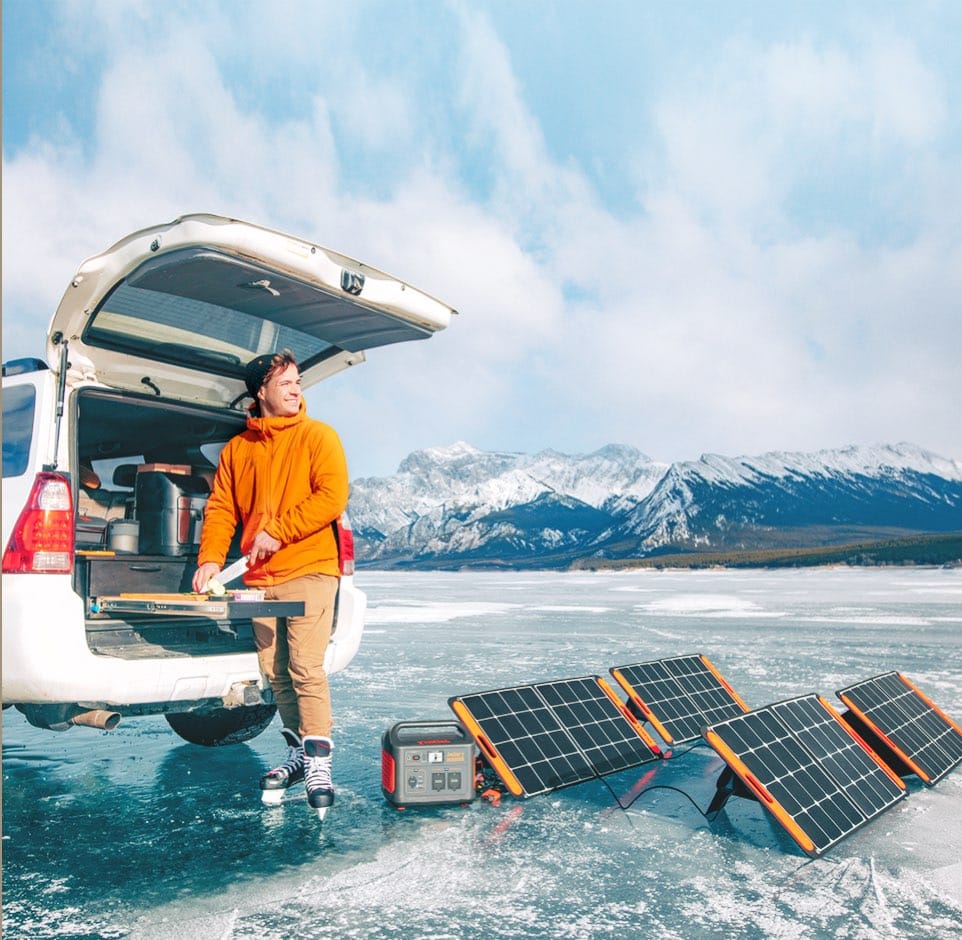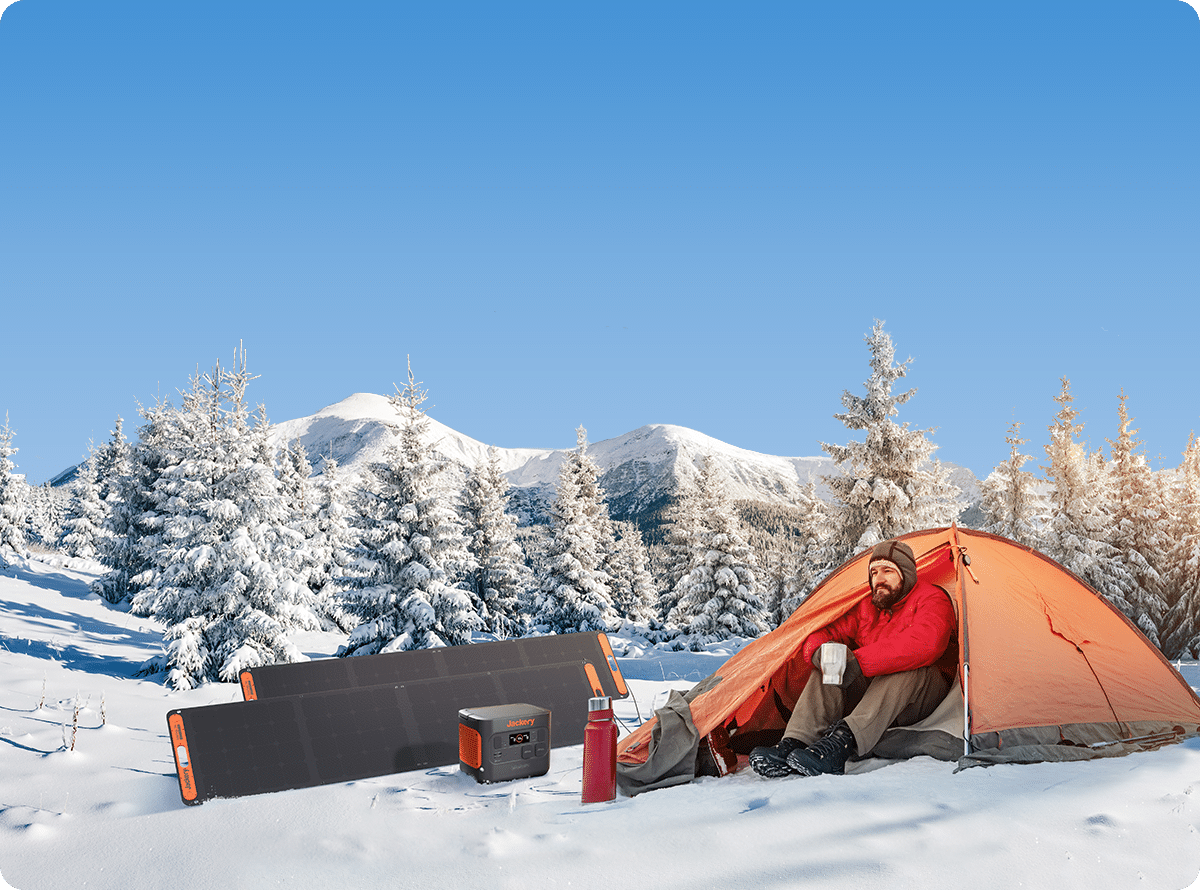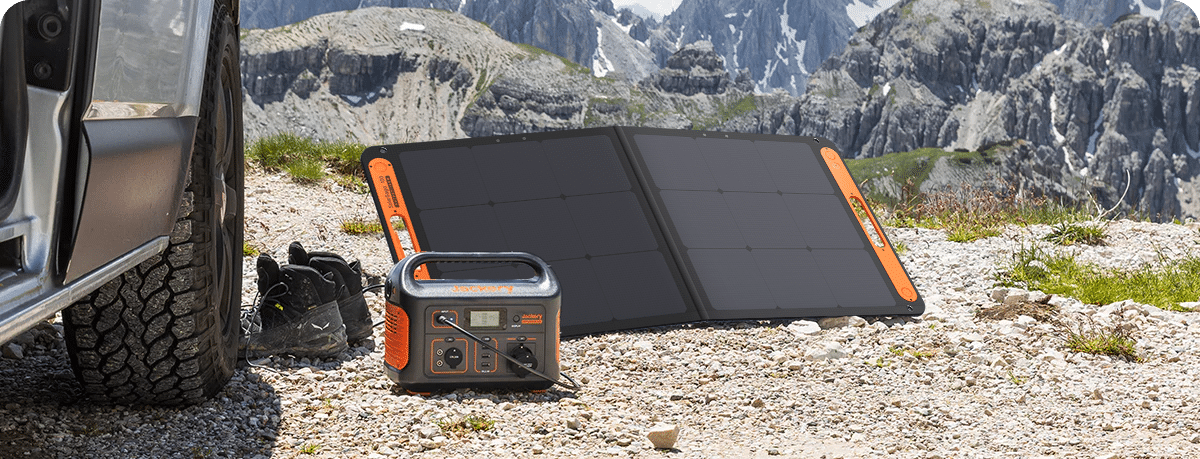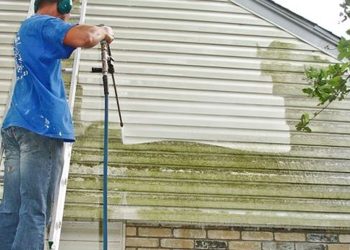Table of Contents

Ice fishing in Europe is a strenuous but rewarding winter activity that requires knowledge of weather, ice thickness, and fish behaviour in frigid temperatures. It may involve lengthy hours on the ice, where trustworthy gear may make or break a day. For instance, powering heated shelters, drilling equipment, and sonar and GPS systems to find fish beneath thick ice layers requires a Jackery portable power station. It also powers safety gear like emergency radios and lights for navigation on short winter days when visibility declines fast. Ice fishing is dangerous even for seasoned fishermen without the correct gear, so preparation is crucial for safety and success.
Why Power is Essential in Ice Fishing?
Challenges of Ice Fishing in Europe
- Extreme sub-zero temperatures and wind chill.
- Thick ice layers needing radical drilling equipment.
- Risk of ice cracking or sudden thaw in late winter.
- Remote and isolated fishing locations.
- Limited daylight hours affecting visibility.
- Equipment malfunctions in freezing conditions
- Protracted exposure triggering frostbite risk.
- Demand for continuous warmth and shelter.
- Difficulty in accessing emergency services.
- Limited or no access to outmoded power sources.
- Navigation and communication issues due to low connectivity.
- High energy demand from heating, cooking, and lighting equipment.
Importance of Reliable Power Sources for Safety and Convenience
In European ice fishing, reliable power guarantees safety and efficiency because exciting conditions demand relentless access to powered equipment. A portable power station can make a difference while sustaining GPS trackers, satellite phones, and emergency beacon lights. Remember, they are the only lifeline in isolated regions with limited signal coverage.
A portable power station also lets anglers operate heated shelters and submersible fish finders without interruption for warmth, visibility, and location accuracy. Power runs electric augers. It breaks thick ice layers and keeps tools and protective gear charged in sub-zero environments. That’s where even short power outages can escalate into dangerous situations. Moreover, a high-capacity power source can keep medical kits active and preserve food supplies. Hence, it prompts a safer, more comfortable fishing experience in Europe’s harshest winter backdrops.
Key Equipment for Ice Fishing
Fishing Rods and Reels
Ice fishing rods and reels differ from those for open-water fishing. Given the limited line movement through a hole in the ice, shorter rods, say around 28 inches, are preferable for increased control in confined spaces. For targeting perch, walleye, or pike, rod power and action must suit the species’ fight response. For example, ultralight rods are appropriate for perch. However, medium-heavy rods suit pike. Reels should have smooth, precise drags because fish movement is amplified under the ice. Quality ice reels with strong anti-freezing lubrication are key to punitive, cold conditions to prevent the reel from seizing. Many anglers utilize inline reels to avoid line twists, which can be an issue in ice fishing, affecting lure presentation.
Ice Auger
Ice augers matter since cutting through ice can range from a few inches to many feet in thick European winters. Gas-powered or electric augers are used over manual ones for clean cuts. Electric augers are efficient, with fewer emissions and lower noise, so they do not scare off fish. However, power source and battery life are also considered. Many electric augers need backup batteries in colds because battery performance can degrade. Gas augers deliver steady torque and cut on extra-thick ice. Still, they need maintenance due to fuel exposure in freezing temperatures. A blade sharpener or spare blades are also helpful since dull blades can waste time and energy.
Shelter or Ice Fishing Tent
Ice shelters or tents have insulated and non-insulated forms. Pop-up and hub-style shelters are popular among experienced anglers. Insulated shelters are heavier, but trap heat is better for a stable environment in freezing temperatures. Models may use triple-layer insulation with a windproof outer shell to bear gusts. It matters for ice fishing in windy areas like Scandinavia. Ventilation is vital. Heaters inside can release harmful carbon monoxide. Modern shelters might include vent flaps for this purpose. Portability is another consideration. Some shelter models feature sledge-like bases for easy towing for those who must relocate recurrently according to fish movement.
Fish Finder
A fish finder can be a game-changer in ice fishing. It offers real-time data on fish location and behaviour beneath the ice. Popular choices among progressive anglers may have high-frequency CHIRP sonar technology for clear images through thick ice. When choosing a fish finder, find devices with high cold-weather performance. Low temperatures can impact the device’s screen responsiveness and battery life. Transducer placement is key. Most ice anglers use suspended transducers for an undisturbed sonar image. Flasher units offer a unique real-time display and are preferred for reading subtle depth changes when targeting bottom-dwelling walleye or burbot.
Ice Fishing Tackle Box
An ice fishing tackle box is also crucial. Ice-specific lures and gear differ from open-water setups. Compact jigs and tungsten lures sink quickly and are favourites for perch and trout. The tackle boxes may have compartmentalized slots to avoid tangling because ice shelters can limit space. Magnetic compartments can secure small ice flies and tungsten jigs that are otherwise easy to lose in the cold. Models feature durable materials to resist cracking in freezing conditions. A watertight seal prevents moisture from affecting sensitive gear. Carrying many line weights and types is vital since ice fishing can demand quick changes per depth and fish type.
Warm Clothing and Gear
Clothing for ice fishing is above just wearing multiple layers. The base layer should be moisture-wicking to manage perspiration. Slight dampness can prompt rapid cooling. Merino wool or synthetic fabrics work best. Mid-layers of fleece or down trap heat, while outer layers must be waterproof and windproof. Gore-Tex materials are preferred for their durability and resistance to snow. Unique ice fishing boots with insulated liners help avoid frostbite for long sessions. Gloves with removable liners enable dexterity when handling bait or setting up gear without exposing skin. Face coverings, balaclavas, and ice-rated safety spikes complete the setup for European regions susceptible to unpredictable snowstorms or temperature drops.
Portable Power Station
Power stations are popular for ice anglers charging multiple devices, including fish finders, electric augers, etc. Portable lithium-ion stations provide reliable power in cold temperatures, unlike lead-acid batteries that lose capacity in freezing conditions. Find stations with high-wattage output and multiple ports (USB, AC, and DC) to support many devices. For European anglers fishing at remote or less accessible locations, a solar panel can help recharge on multi-day trips. Also, models may offer built-in inverters for steady power flow to electronics. It matters when using high-tech gear that might be affected by power fluctuations in the cold.
Benefits of Using Portable Power Stations
Silent Operation
Ice fishing in Europe means close-quarters setups on tranquil frozen lakes. Here, noise is disruptive. Portable power stations provide silent operation and exclude the noise of gas-powered generators. With no combustion engines, they produce no sound beyond a faint hum. It respects the serenity of the natural surroundings. Plus, it helps anglers fish with negligible disturbance when targeting noise-sensitive trout or perch. So, many European ice anglers choose portable power stations over generators. It matters in areas where sound restrictions apply or quiet environments should avoid scaring fish. Multi-day fishing trips enrich the quality of the night fishing experience without drawing attention or breaking the peace of the winter site.
Lightweight and Portable
With augers, shelters, and fishing equipment, winter fishing gear already contains a load. Traditional lead-acid batteries or gas generators add weight and bulk, which don’t suit anglers moving between fishing spots. Portable power stations cut this load with lithium-ion or LiFePO4 batteries. For instance, a lithium-based portable power station weighing under 10 kg can deliver a similar or greater power output than a lead-acid battery twice its weight. The portability factor is helpful in Europe’s ice-fishing regions because access may comprise trekking over icy, uneven terrain. In some models, portable power stations have ergonomic handles, compact form factors, and wheeled cases to simplify transport across rugged, snowy surfaces. It helps anglers shift locations and optimize their fishing experience without losing access to reliable power.
Multiple Charging Options
Portable power stations are flexible, with multiple charging methods for different conditions and durations of ice-fishing trips. They may support charging through standard AC outlets, 12V carports, and solar panels so anglers can recharge in the field using renewable sources. Solar charging benefits remote European regions with little to no infrastructure, so anglers may set up foldable solar panels on the ice. For example, employing a 100W solar panel on a sunny winter day, a 500Wh portable power station might reach full charge in 6-8 hours to power sonar devices, heated blankets, and lights throughout a day of fishing. Charging from multiple sources also guarantees that portable power stations can be reliable power sources on multi-day fishing expeditions. That’s where consistent access to grid power is unmanageable.
Eco-Friendly
Customary generators emit noise and CO2 pollutants and may leak oil to harm the angler and the environment. Portable power stations eradicate such emissions while running on batteries and renewable energy for recharging. It is relevant in environmentally protected European areas since authorities impose guidelines to preserve water and soil quality. Many European anglers are moving to eco-friendly solutions to support regional conservation and personal sustainable practices. Furthermore, lithium-based portable power stations are efficient, converting more stored energy into power than fossil-fuel-based alternatives. Solar-powered generators mean portable power stations support a much lower environmental impact for eco-conscious anglers.
Emergency Backup Power
Ice fishing can be erratic. Sudden weather changes and equipment failures are challenges. Solar generators, including portable power stations and solar panels, are emergency backups for a dependable power source to keep communication devices, heaters, and GPS units active in long exposure to cold or sudden storms. In remote European ice-fishing spots, temperatures can drop rapidly. So, reliable power can be life-saving. Such power stations can sustain devices for hours, if not days, depending on usage. Also, some models have built-in emergency lights and SOS signals for many emergency functionalities in a single device. Given Europe’s high safety standards for outdoor activities, portable power stations as emergency backups are dear for safety in winter fishing environments.
Spotlight on Jackery Explorer 500 Portable Power Station
Due to its lightweight (6 kg) design, the Jackery Explorer 500 Portable Power Station is ideal for European ice fishermen. With a 518Wh lithium-ion battery, this solar generator offers reliable energy storage, so it can sustain lights, heaters, and small electronics in freezing temperatures. Its output flexibility is valuable. With one 230V AC outlet for 500W continuous output and 1,000W surge, two 12V DC outputs, and three USB-A ports, it allows the use of multiple devices to power fish finders, small heating units, and mobile devices for long ice fishing trips.
The unit’s pure sine wave inverter gives a steady, safe output for electronics to avoid power fluctuations that could be harmful. With wall (7.5 hours), car (7.5 hours), and solar via a Jackery SolarSaga 100W solar panel (9.5 hours) recharging options, anglers can adapt to any situation, whether on-site or from a vehicle. Besides, with a quiet operation level of 46 dB, it keeps a peaceful environment for ice fishing. The portable power station’s rugged build quality and cold-temperature compatibility (-10 to 40 °C) benefit remote and extreme winter settings. Its intelligent BMS boosts protection against overvoltages and short circuits when charging in capricious weather.
Practical Applications of Portable Power Stations in Ice Fishing
- Powering portable heaters in fishing tents.
- Charging smartphones and other mobile devices.
- Running fish finders and underwater cameras.
- Operating LED lights for nighttime visibility.
- Powering small cooking appliances (e.g., electric grills, kettles).
- Charging batteries for electric drills and augers.
- Running portable fridges or coolers for bait and food preservation.
- Charging GPS devices for navigation.
- Running radios or communication devices.
- Operating air pumps for ice shelters.
- Powering electric blankets or heating pads.
- Recharging portable power tools or equipment batteries.
- Operating fans for tent ventilation.
Conclusion
Due to frigid weather, thick ice, and inaccessible places, European ice fishing needs electricity for safety and comfort. In low light and difficult settings, a Jackery power station may power heated shelters, fish finders, and emergency radios. It also powers lights, cooking, and navigation systems for a better ice experience. If you’re going winter fishing, bring the best portable power station to keep your gear working, remain comfortable, and fish assuredly in adverse conditions.










